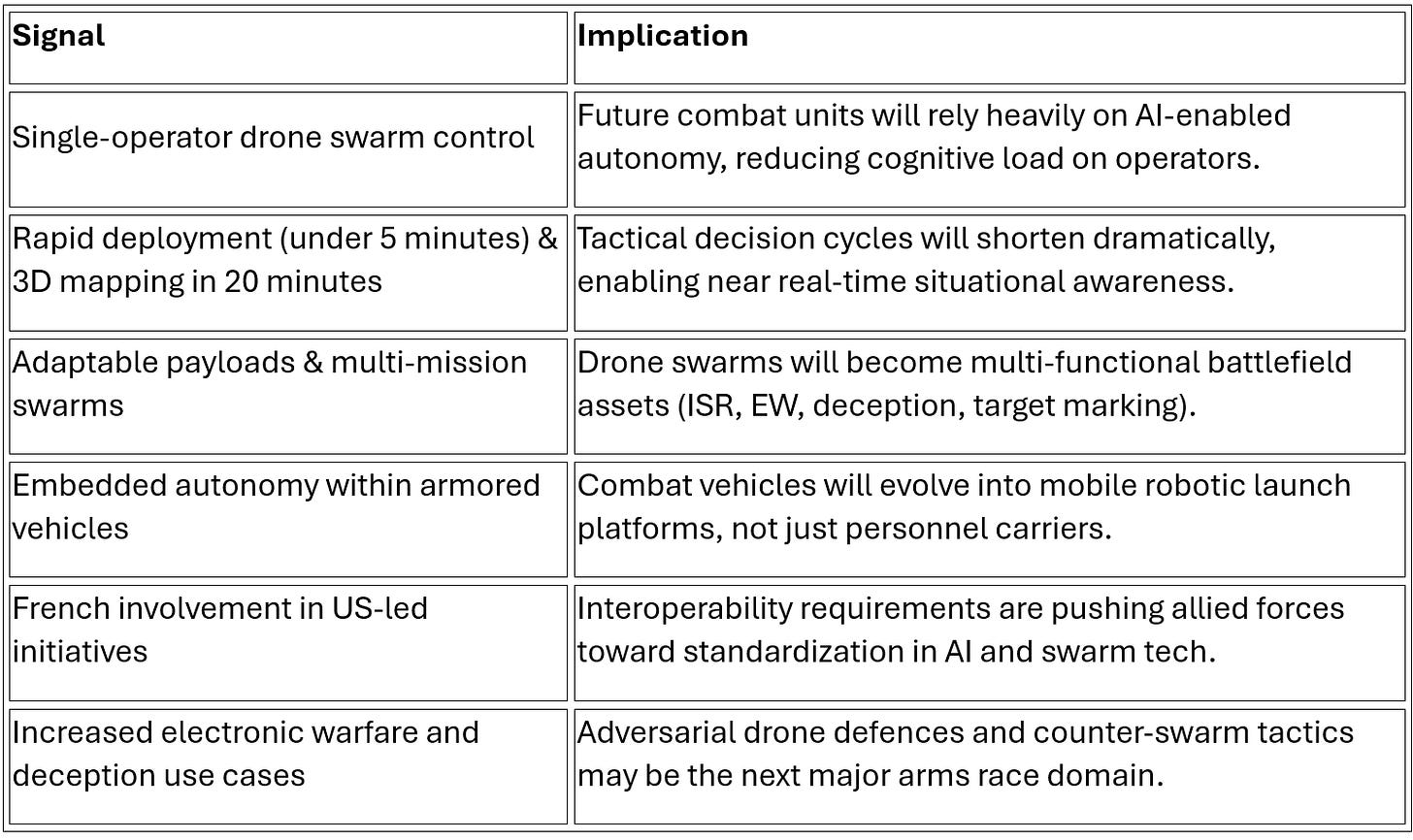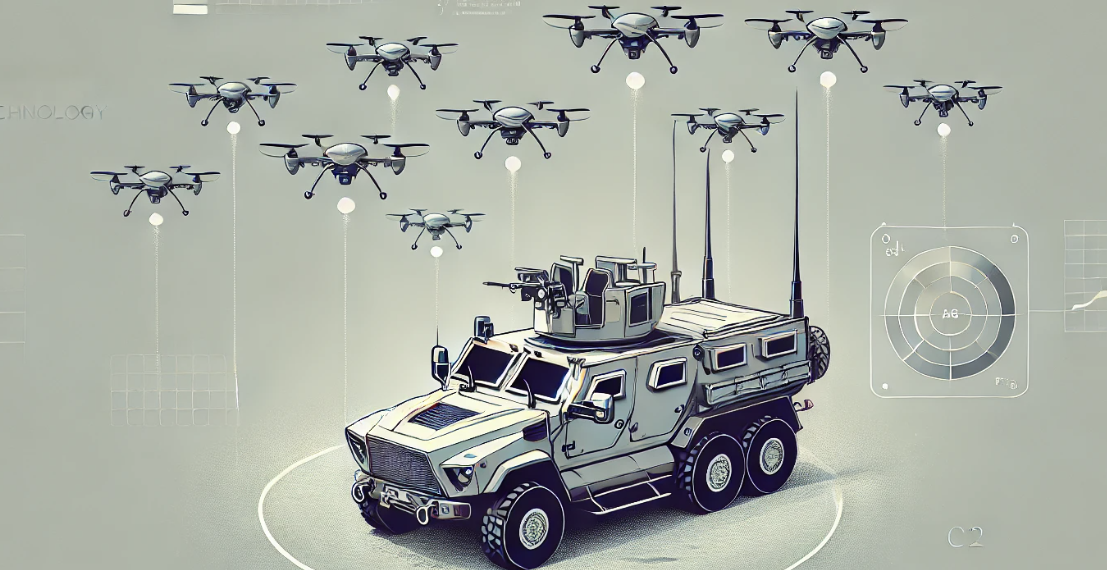This is the second Foresight Navigator article that FutureWerx has republished with the permission of the author, Jenn Whiteley. While the focus of FutureWerx is imagining the future of conflict through the lens of emergent and frontier technologies (i.e. what is emerging from the world’s research laboratories rather than what is happening on the world’s battlefields), Mrs. Whiteley’s insights regarding the application of emerging unmanned systems swarming technologies are impactful and worthy of increased attention given the incredibly rapid pace of development of these technologies today. These capabilities are real, they are here today – not tomorrow – and the implications profound. What is next for defense…and offense?
Written By: Jenn Whiteley
The French Foreign Legion tested “automated hives” — vehicle-based systems that let one operator quickly launch and control multiple drones — during exercises in France and at the U.S. Army’s Capstone 5 in California. The Infantry Robotic Intelligence Section (SRRI) deployed a swarm of aerial drones from a Griffon Multi-Role Armored Vehicle (VBMR), showcasing the rapid advancements in autonomous systems.
This effort brought together forces from the United States, the United Kingdom, Australia, Canada, and New Zealand to test new technologies in robotics, air defence, and communications.
Key Takeaways
- Autonomous Swarms Operationalization
The French Foreign Legion is demonstrating real-world deployments of drone swarms from vehicles using automated “hives.”- One operator can control up to 8 drones (potentially scaling up to 20 drones).
- Swarms can be deployed in under five minutes and conduct 3D modeling of terrain in 20 minutes.
- Integrated Command & Control (C2)
These systems are integrated into existing platforms (Griffon and Masstech vehicles), signaling that future battlefield designs may increasingly pair manned vehicles with autonomous extensions.- Unified C2 is critical: human-machine teaming is being designed around one operator interfacing with multiple semi-autonomous systems.
- Mission Adaptability & Tactical Scenarios
Drone payloads are adaptable for:- Reconnaissance and mapping
- Target marking
- Deception and electronic warfare
- Allied Interoperability & Joint Experimentation
Participation in #ProjectConvergence at the US National Training Center (California) shows deepening cooperation between France, the US, and other Five Eyes partners for future conflicts through 2040.- The integration of the French 6e BLB under the 82nd Airborne Division is notable for future coalition operations.
Signals and Implications for Future Warfare

Mission adaptability is at the core of drone swarm utility. Combat vehicles are no longer just armored transports — they are becoming mobile launch platforms for autonomous systems. Integrating drone hives into vehicles like the Griffon means that these platforms can deploy sensors, gather real-time intelligence, mark targets, and disrupt enemy forces. This flexibility means commanders can adapt quickly, using the same drones for different missions as the situation changes, reducing the need for multiple specialized systems.
Drone swarms are becoming a key tool for deception and electronic warfare on the battlefield. By jamming communications, they can disrupt enemy coordination and slow responses. They can also generate false signals or simulate troop movements, creating confusion and forcing adversaries to react to threats that aren’t real. This ability to mislead and overwhelm with minimal risk gives commanders a new layer of control.
Interoperability means allied forces need to plug their systems into each other without delay or confusion. For AI and swarm tech, this looks like common communication protocols, shared control interfaces, and data formats that allow drones from different nations to fly together, share sensor data, and respond to commands from other allied operators. It also means standardizing security measures so that swarms can operate in joint missions without risking interference or compromise. Without interoperability, drone swarms are just local assets; with it, they become part of a global mesh of sensors and responders, enabling coalition forces to think, see, and act faster than any opponent.
Rapid three-dimensional modeling within 20 minutes means commanders can quickly turn raw drone footage into detailed, usable maps that reflect the current state of the battlefield. This process captures not just terrain but structures, obstacles, and movement patterns, giving forces a precise view of the environment they’re operating in. It reduces reliance on outdated data and allows teams to adjust plans on the fly, coordinate with allies using the same reference points, and make faster, more informed decisions in complex, changing situations. Instead of scanning feeds manually, the operator receives alerts and visual cues, making decisions faster and with better information.
The French Foreign Legion’s drone swarm capability is supplied by Icarus Swarms, a French defence company specializing in autonomous drone systems for military and security use. Their focus on European manufacturing ensures control over quality and supply, while rapid prototyping allows them to evolve quickly in response to operational demands. Continuous field testing is at the core of their model — new features and improvements are validated directly in military exercises, not just in labs. This approach reflects a shift from long development cycles to agile, iterative design, where feedback from real missions directly shapes the product.
Questions this raises for future planning:
- Will future battalion- and brigade-level formations include dedicated drone swarm operators and vehicle-integrated hives as standard assets?
- How will military doctrine evolve to incorporate swarm tactics beyond ISR?
- What ethical and policy frameworks will govern autonomous swarm deployment for kinetic missions?
- How will military logistics adapt to support the mass deployment and maintenance of swarms in contested environments?
- How quickly can militaries align on procurement and technical standards for swarms?
“The increasing use of drone swarms in military operations reflects an ongoing transformation in operational tactics, where automation and artificial intelligence are reshaping battlefield strategies.”








